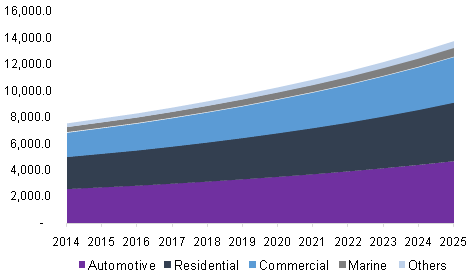Window Films Market Analysis By Product (Sun Control, Decorative, Safety & Security, Privacy), By End-Use (Automotive, Construction (Commercial, Residential), Marine), Trends, Dynamics, Competitive Insights And Segment Forecasts, 2014 – 2025
Industry Insights
The global window films market size was valued at USD 7.93 billion in 2015. The market is expected to witness considerable growth owing to increasing demand from end-use industries including automotive, construction, and marine. Surging use of window films in green buildings and net zero energy buildings is anticipated to drive its consumption in the construction sector.
Stringent regulatory environment in developed economies such as the U.S. and Germany to reduce carbon dioxide emissions coupled with concerns related to energy conservation is likely to boost demand over the forecast period. However, rising consumer awareness regarding environmental sustainability along with low prices is expected to drive industry growth.
It is a thin film or laminates made up of polyester, which can be installed on interior glass surfaces or exterior glass surfaces in residential & commercial buildings, automobiles, boats and marine applications. The durability and performance of these products are determined by the quality and type of component used.
Global window films market revenue by end-use, 2014 – 2025 (USD Million)

Polyester is used as a raw material owing to its tensile strength, durability, clarity, and dimensional stability. Bio-based polyester is used in window films which can reduce the dependency on fossil resources and improve carbon footprint.
Growing consumer awareness regarding its benefits coupled with increasing per capita disposable income in emerging economies of Latin America and Southeast Asia is another key factor driving industry growth.
Window films are expected to have adverse impact owing to limitations on Visible Light Transmission (VLT). Window tinting in automobile reduces the VLT through car windows, and low visibility can lead to theft or accident especially at night drives.
Product Insights
The sun-controlled was the largest product segment and accounted for a share of over 45% in 2015. The increasing use of sun-control in residential and commercial applications owing to the occurrence of skin diseases is likely to propel demand.
Furthermore, extreme weather conditions in countries such as India, Saudi Arabia, Brazil, and Mexico is driving the demand for the sun-control product segment. Direct UV radiation exposed from the sun, is responsible for the 90% of all skin cancer. It helps to reduce solar heat gain and maintain the sustainable and comfortable environment.
Global window films market revenue share by product, 2015

Security and safety segment is expected to grow at a CAGR of over 5% from 2016 to 2025. They provide protection against natural disasters such as storms, earthquakes, explosions, and vandalism. It also helps to hold the glass fragment together at the time of natural calamities.
End-Use Insights
The automotive segment accounted was valued at over USD 2.7 billion in 2015. This segment accounted for a significant share of demand owing to increasing fuel efficient passenger cars. They are used to improve aesthetic values, reduce solar heat gain, and enhance styling & protection. Automotive window films block more than 99% of harmful ultraviolet rays and protect against skin damages.
Residential construction is expected to be the fastest growing segment, with a CAGR of over 5% from 2016 to 2025. Increasing construction spending in developing economies of Asia Pacific and the Middle East such as India, Thailand, Saudi Arabia and Qatar is expected to generate significant demand. They find wide application scope including restricting fading of furniture, paints & coatings of rooms, and carpets in residential and commercial applications.
Increasing demand from coastal economies for naval sectors coupled with escalating trade activities across borders is expected to drive the marine industry. It provides protection to interior components such as audio equipment, cell phones, speakers and other marine electronics.
Regional Insights
North America led the global industry and accounted for over 34% of the region in 2015. Increasing purchasing power of consumers coupled with technological advancements such as the advent of bio-based polyester film are expected to fuel growth. Growing consumer awareness regarding benefits of these films along with the recovery of automotive industry is expected to fuel consumption in the region.
North America window films market revenue by country, 2014 – 2025 (USD Million)

Asia Pacific market is expected to witness the highest growth owing to surging automotive and construction industries. The shift of manufacturing base to countries such as India and China and Southeast Asian countries due to lucrative business environment along with cheap labor is anticipated to fuel industry growth. Government subsidies and tax incentives for energy efficiency coupled with rising consumer awareness are expected to drive demand in the region.
Europe was the second largest region in terms of volume and revenue in 2015. The region is characterized by revival of automotive and construction sector post a slow patch that occurred during 2010-2014. Countries such as Germany, France, Italy and Spain are profoundly investing in residential and construction projects funded by private and government organizations. Automotive industry in the European region has witnessed increased sales in passenger and commercial vehicles over the last two years.
Competitive Insights
Major companies operating in the global sector include 3M, Eastman, Flyvinci, Madico, Toray Plastics, Hanita Coatings, Johnson, Armolan, Rayno, Suntek, Reflectiv, and Nexfil. Toray Plastics has developed bio-based polyester to manufacture sun control films for residential and commercial applications.

